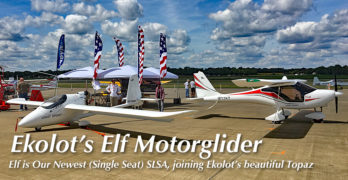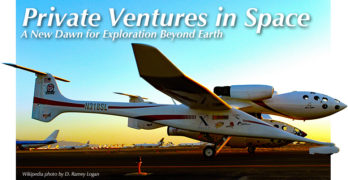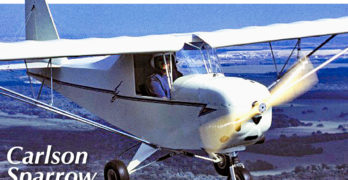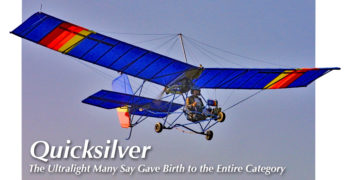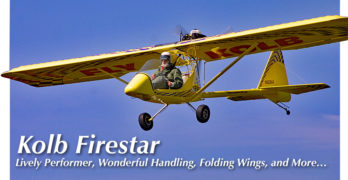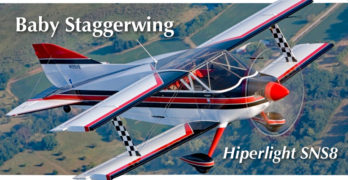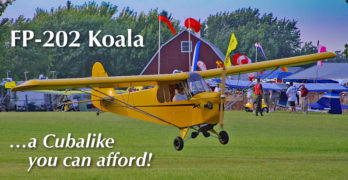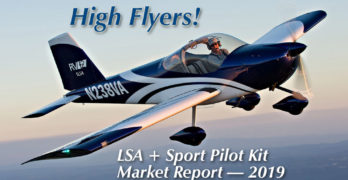Welcome to the newest Special Light-Sport Aircraft …except that it isn’t so new(1). Indeed, we’ve seen the Ekolot Elf for a few years in this country. Here’s what I wrote on its introduction in 2017.
I was immediately drawn to Elf for two reason: One, I love soaring flight, which represents one of the most enjoyable challenges I’ve found in flying. “Hooking” a thermal and riding it thousands of feet upwards with the engine off or idling is not only magical; it’s also a good skill development exercise. Two, Elf was initially promoted as a Part 103, which I believe is aviation’s most charming — and certainly least-regulated — segment. Low prices, no pilot license required, no N-numbers, no medical of any kind …well, no wonder Part 103 aircraft are selling so well the last few years.
In Germany they have the “120-Kilogram Class,” meaning airplanes that weight no more than 264 pounds (very similar to the U.S.
Search Results for : Part 103
Not finding exactly what you expected? Try our advanced search option.
Select a manufacturer to go straight to all our content about that manufacturer.
Select an aircraft model to go straight to all our content about that model.
Light-Sport Aircraft In Space? OK, Not Quite but Private Ventures Are Advancing Quickly
Don’t hate me… I know this short article is not about Light-Sport Aircraft. Call it another break from the never-ending news about coronavirus.
You can call the title “clickbait” if you want, but I’ve long had a strong interest in space flight and SpaceShipOne certainly was far lighter than any manned spacecraft NASA has launched.
Still, even this light and relatively simple spacecraft is about as far from Part 103 ultralights as you can get.
It’s the main man behind this space adventure that may be of greater interest to pilots of any certificate.
I was initially captured by the video below. When I realized it was an interview with Burt Rutan, I was drawn to see what this tell-it-like-it-is fellow had to say.
I’ll keep this short as it doesn’t relate to Light-Sport Aircraft, kit-build aircraft Sport Pilots may fly or ultralight aircraft. For you true believers — don’t worry.
Return of An Old Favorite — Carlson Sparrow May Appear at Oshkosh 2020
Having celebrated the inventiveness of ultralight designer Wayne Ison in the last post, it seems quite appropriate to recognize another, Ernie Carlson. Does that ring a bell for you? One hopes.
Ernie was the man behind Carlson Aircraft along with his wife, Mary. This pair introduced Sparrow, a Part 103-capable single-place ultralight plus larger models like Sparrow II and XTC.
I won’t say they’ve been lost to pilots but they’ve been hiding. Now, out of the history books will return the Sparrow, thanks to David Cooper, the man behind Team Mini-Max. Our tenth of ten Vintage Ultralights featured his work and below you can see a video interview with him below talking about the Mini-Max line that he is also keeping alive and well.
Carlson Sparrow And Friends
“With the help of a couple partners we bought the Carlson Sparrow company. It will still carry the four designs they created and will be located next door to Team Mini-Max LLC in Niles, Michigan,” advised David.
Ultralight April 2020 — Eighth in the Vintage Series: Quicksilver MX
Ah, the Quicksilver! Where to start with this veritable icon of the ultralight sector?
With more than 15,000 flying, it even outranks Van’s Aircraft for kit aircraft that made it into the air — although Van’s has sold more kits in total and no one disputes the Western brand’s leadership position.
The earliest Quicksilvers were hang gliders (last photo). Engines came later but at first the weight-shift seat stayed (nearby image). The pilot had lateral control — still by weight shift — but via lines that moved surfaces. Pitch, however, was fully controlled by the pilot moving his or her body.
Those were fun days and provided wonderful memories (yes, I flew them as weight-shift aircraft). Yet the brand went on to vastly greater development. In this article, our focus is on the original three-axis control model, the oh-so-famous MX (multiple axis).
Quicksilver MX
Quicksilver’s MX entered the market in the early 1980s, like all the models featured in our Vintage Ultralight series.
Ultralight April 2020 — Fifth in the Vintage Series: Kolb Firestar
Amazingly enough, here in 2020, we have noticeably returned to our roots in very light aircraft. Almost 40 years after Mike Sacrey and his team at FAA created the still-incredible Part 103, one leading brand from those days is not only still in business and thriving, but they are largely building similar aircraft to four decades back.
The man you saw on the lead photo is the famed Dick Rahill, a one-man flying machine flying his machine at Sun ‘n Fun more capably than any robot. Over and over, Dick would blast off in the bright yellow Firestar that seemed attached to him. He’d make one quick pattern from the turf runway in Paradise City at Sun ‘n Fun only to land, jump right back in the takeoff line, and repeat. Launch, circle, land, repeat… over and over. It seemed like every other airplane taking off was Dick and his FireStar.
Ultralight April 2020 — Fourth in the Vintage Series: Hiperlight SNS 8 Biplane
As we continue with this fourth in a series of ten about very affordable light aircraft from earlier times, we stress again that all the aircraft presented in this series still have some essential qualities that warranted their inclusion.
First, these are all aircraft with which Videoman Dave and I are personally familiar. I have flown all but one on the list and I believe Dave has flown all of them. So, we come to the series with real experiences in these flying machines. It has been a while for many of them, but assuming maintenance is good (see the important message at the end), this can be reasonable for many pilots to consider. However, as with any used aircraft, the buyer must be aware. Neither Dave nor I can comment on any one particular aircraft.
Second, and with the maintenance message firmly planted in your mind, all the models in this Vintage Ultralight series still have parts available from current-day producers.
Ultralight April 2020 — Third in the Vintage Series: Fisher FP-202 Koala
When Fisher was still located where it began, in North Dakota, I paid a visit to the factory. It may have been the tidiest wood shop I have ever seen.
I had just written an article about kit-builder assembly manuals so I was keen to see examples of Fisher Flying Products full-size plans. That always sounded like a marketing term yet I knew it meant exactly what they called it.
Darlene Hansen showed me a neatly-organized series of boxes full of long tubes of paper. She took one out, for the fuselage of the Koala as it turned out (see nearby image). She went to one end of a long, flat table and briskly unfurled the tube of paper while hanging on to the loose edge. It rolled and rolled …and rolled, until a sheet about four feet wide and 20 feet long covered the work table.
You literally take the tiny wood pieces Fisher ships to you as part of the kit and lay them directly on the paper as shown.
Ultralight April 2020 — First in the Vintage Series: Buccaneer XA
A frequent comment I hear is that the price of recreational aircraft are too high. Some pilots have been stating this for 18 years, since a couple years before Light-Sport Aircraft emerged.
Back in 2002, many believed that the new LSA-to-come would cost $50-60,000. Right or wrong (about those price guesstimates), that range today would be $72-87,000, after correcting for the decline in the dollar’s purchasing power. The truth is that you do have some new choices at that price point but for many, such a cost remains out of their budget for any recreational vehicle, airborne or otherwise.
To those pilots, I often suggest a good, used aircraft and we have more such LSA every year, many of which are excellent buys. Yet, how about we drop down the price further?
How About a Used
Part 103 Ultralight?
Long before LSA were introduced, I flew a single-place Buccaneer with a Rotax 377.
Full-2019 Market Share Report for Light-Sport Aircraft and Sport Pilot Kit Aircraft
We have a new year upon us. With our new reporting capabilities for LSA and SP kit market shares, we can now quickly report results from 2019.
A huge thanks to our supreme “datastician,” Steve Beste for making such swift and accurate reporting possible. I assure you that I’ve looked high and low for every year LSA have existed to find no comparable information.
As always, be advised that our data comes from FAA’s aircraft registration database. That means it is impartial — hopefully meaning reliable and dependable — but it also means some massaging of the information is needed to be completely accurate. (See this article for more detail on the effort involved; it is not trivial.) Steve’s valuable ability to manipulate database resources combines with his knowledge of light aircraft to make an unbeatable combination.
As much as any data allows — and as the saying goes… “you can take this info to the bank.” It’s solid!
Start the Countdown: Four Years Will Bring Huge Changes to Light-Sport Aircraft
As we kick off a new year and a new decade, it feels like the starter’s timer has just been clicked into action. The next four years should prove to be highly interesting — and for all of aviation, not only Light-Sport Aircraft, Sport Pilot kit aircraft, and ultralights. Change can be difficult, but it’s coming. For the most part, I feel this is heading in a great direction even if some may struggle with elements of the new rule.
Earlier, an often-shared report discussed the changes FAA plans as part of a “deregulation” of Light-Sport Aircraft. Below, you can see a video that stimulated numerous comments.
An updated report is still being prepared from a late-fall 2019 discussion with FAA rule writers. That will be sent to LAMA members first with specific details. Other industry pros will get a simpler update so all the makers of our great aircraft can be prepared when the rule is issued no more than four years from now.
- « Previous Page
- 1
- …
- 16
- 17
- 18
- 19
- 20
- …
- 53
- Next Page »


